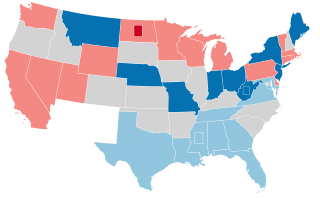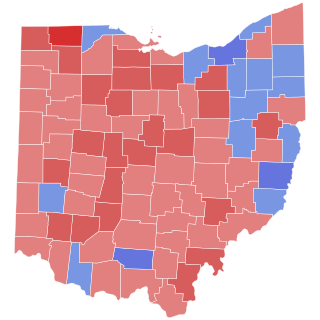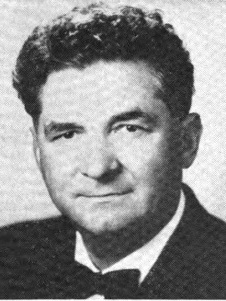
The 1958 United States Senate elections were elections for the United States Senate which occurred in the middle of President Dwight D. Eisenhower's second term. Thirty-two seats of Class 1 were contested in regular elections, the new state of Alaska held its first Senate elections for its Class 2 and 3 seats, and two special elections were held to fill vacancies.

The 1940 United States House of Representatives elections were elections for the United States House of Representatives to elect members to serve in the 77th United States Congress. They were held for the most part on November 5, 1940, while Maine held theirs on September 9. They coincided with President Franklin D. Roosevelt's re-election to an unprecedented third term. His Democratic Party narrowly gained seats from the opposition Republican Party, cementing their majority. However, the election gave firm control of the US House of Representatives and Senate to the New Dealers once again, as Progressives dominated the election.

The 1914 United States Senate elections, with the ratification of the 17th Amendment in 1913, was the first time that all seats up for election were popularly elected instead of chosen by their state legislatures. And thus it became the first time that they were generally scheduled on Election Day to coincide with the U.S. House elections. The 32 seats of Class 3 were contested in regular elections in 1914. Special elections were also held to fill vacancies. These elections occurred in the middle of Democratic President Woodrow Wilson's first term.

The 1910–11 United States Senate election were held on various dates in various states. As these U.S. Senate elections were prior to the ratification of the Seventeenth Amendment in 1913, senators were primarily chosen by state legislatures. Senators were elected over a wide range of time throughout 1910 and 1911, and a seat may have been filled months late or remained vacant due to legislative deadlock. However, some states had already begun direct elections during this time. Oregon pioneered direct election and experimented with different measures over several years until it succeeded in 1907. Soon after, Nebraska followed suit and laid the foundation for other states to adopt measures reflecting the people's will. By 1912, as many as 29 states elected senators either as nominees of their party's primary or in conjunction with a general election.

The 1988 United States Senate election in Ohio was held on November 8, 1988. Incumbent Democratic U.S. Senator Howard Metzenbaum won re-election. Metzenbaum easily won the Democratic nomination with over 80% of the vote, while Cleveland Mayor George Voinovich was uncontested in his primary. This was the last U.S. senator to win in the Democratic party at this seat until 2006. In addition, Metzenbaum's 56.97% of the vote is to date the best performance for a Democrat running for the U.S. Senate in Ohio, though Sherrod Brown, a Democrat nearly broke that in 2006. Voinovich would later be elected in the other Senate seat ten years later. As of 2022, this remains the last time that Ohio would support different parties in a concurrent presidential and Senate election.

The United States Senate election of 1942 in Massachusetts was held on November 3, 1942. Republican incumbent Henry Cabot Lodge Jr. was re-elected to a second term in office over Democratic U.S. Representative Joseph E. Casey.

The 1974 United States Senate election in Ohio took place on November 3, 1974. It was concurrent with elections to the United States House of Representatives. Incumbent Democratic U.S Senator Howard Metzenbaum was running for election his first full term after he was appointed in 1974 by Ohio governor John J. Gilligan to fill out the Senate term of William B. Saxbe, who had resigned to become United States Attorney General. Metzenbaum lost the primary election to John Glenn, who went on to win the general election and win every county in the state. Metzenbaum would later be elected in the other U.S. Senate seat in 1976 and worked with Glenn until he retired from the post in 1994.

The 1946 United States Senate elections in Ohio was held on November 5, 1946, alongside a concurrent special election to the same seat.

The 1982 United States Senate election in Ohio took place on November 2, 1982. Incumbent Democratic U.S. Senator Howard Metzenbaum was re-elected to a second term in office, defeating Republican State Senator Paul Pfeifer. Along with the gubernatorial election that same year, this election is the last time Butler County voted Democratic in a statewide election.

The 1970 United States Senate election in Ohio took place on November 3, 1970. Incumbent Democratic Senator Stephen M. Young did not run for re-election to a third term in office. U.S. Representative Robert Taft Jr. won the open seat over Democrat Howard Metzenbaum.

The 1968 United States Senate election in Ohio took place on November 5, 1968. Incumbent Senator Frank Lausche ran for re-election to a third term, but lost the Democratic primary to former U.S. Representative John J. Gilligan. Before losing the primary to the more solidly liberal Gilligan, Lausche had one of the most conservative voting record among Senate Democrats, leaving the Democratic Party very disappointed. In the general election, Gilligan lost to Republican Ohio Attorney General William Saxbe in a very close race. Saxbe's victory increased the number of Senate Republicans in the 91st Congress. He would serve 5 years in the Senate before being nominated by President Richard Nixon to be U.S Attorney General, he resigned the seat after being confirmed. Gilligan, who in January 1974 was serving as the Governor of Ohio, named Saxbe's successor.

The 1944 United States Senate election in Ohio took place on November 7, 1944. Incumbent Republican Senator Robert A. Taft, first elected in the Republican wave of 1938, was narrowly elected to a second term in office over Democratic former Lieutenant Governor William G. Pickrel, winning 71 of Ohio's 88 counties. Despite Pickrel winning the state's largest urban centers such as Cleveland, his margins there were overcome by Taft's strong showings in the rural areas and small towns. Nevertheless, at less than a point, Taft's victory was significantly smaller than his 7 point win in 1938.

The 1928 United States Senate special election in Ohio was held on November 6, 1928 to elect a successor to Frank B. Willis, who died in office in March 1928. Republican U.S. Representative Theodore E. Burton, who previously held this seat from 1909 to 1915, won the open race to succeed him.

The United States Senate special election in Ohio of 1954 was held on November 2, 1954 to complete the unexpired term of late Senator Robert A. Taft, who died in office on July 31, 1953. Interim Senator Thomas A. Burke ran to complete the term in office but was narrowly defeated by U.S. Representative George Bender.

The 1930 United States Senate special election in Ohio was held on Tuesday November 4, to elect a successor to Senator Theodore E. Burton, who died in office in October 1929. United States Representative Roscoe C. McCulloch, who was appointed to fill the vacant seat, was to complete the term but was defeated by United States Representative Robert J. Bulkley.

The Cleveland mayoral election of 1939 saw the reelection of the Republican Harold Hitz Burton to a third term as the Mayor of Cleveland over the Democratic John O'Donnell.

The Cleveland mayoral election of 1941 saw the election of Frank Lausche, who defeated incumbent mayor Edward J. Blythin, who had assumed the office when Harold Hitz Burton resigned as mayor to take a seat in the United States Senate.

The 2022 United States Senate election in Ohio was held on November 8, 2022, to elect a member of the United States Senate to represent the State of Ohio. Republican writer and venture capitalist J. D. Vance defeated Democratic U.S. Representative Tim Ryan to succeed retiring incumbent Republican Rob Portman.

The November 2022 United States House of Representatives election in Alaska was held on Tuesday, November 8, to elect a member of the United States House of Representatives to represent the state of Alaska. Democratic incumbent Mary Peltola won reelection to a full term in office, defeating Republicans Sarah Palin and Nick Begich III and Libertarian Chris Bye in the runoff count.

On March 10, 2021, Marcia Fudge resigned her seat in the United States House of Representatives after being confirmed by the United States Senate to serve as the Secretary of Housing and Urban Development in the Biden administration. Governor Mike DeWine set the primary date for August 3, concurrent with the special election in Ohio's 15th congressional district. The general election was on November 2. Shontel Brown won both the competitive Democratic primary and the general election, and was sworn in on November 4.




















